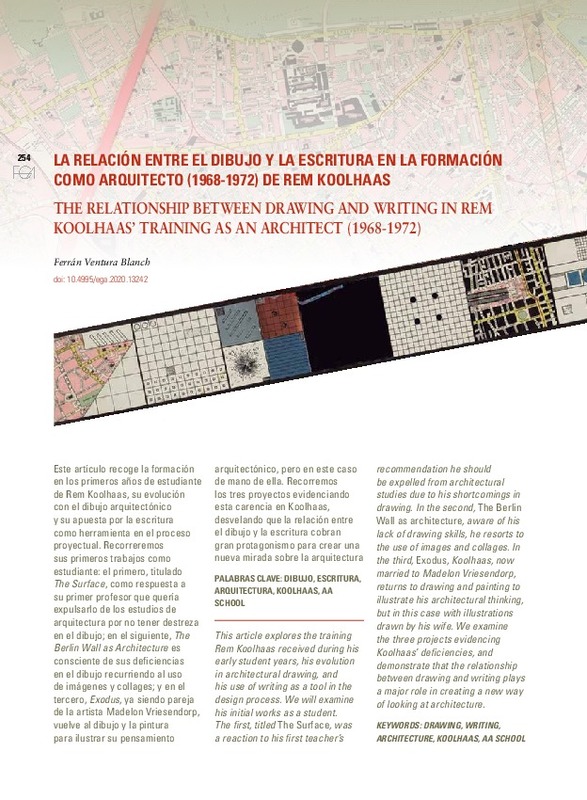JavaScript is disabled for your browser. Some features of this site may not work without it.
Buscar en RiuNet
Listar
Mi cuenta
Estadísticas
Ayuda RiuNet
Admin. UPV
The relationship between drawing and writing in Rem Koolhaas’ training as an architect (1968-1972)
Mostrar el registro sencillo del ítem
Ficheros en el ítem
| dc.contributor.author | Ventura Blanch, Ferran
|
es_ES |
| dc.date.accessioned | 2021-01-19T13:34:37Z | |
| dc.date.available | 2021-01-19T13:34:37Z | |
| dc.date.issued | 2020-11-17 | |
| dc.identifier.issn | 1133-6137 | |
| dc.identifier.uri | http://hdl.handle.net/10251/159434 | |
| dc.description.abstract | [EN] This article explores the training Rem Koolhaas received during his early student years, his evolution in architectural drawing, and his use of writing as a tool in the design process. We will examine his initial works as a student. The first, titled The Surface, was a reaction to his first teacher’s recommendation he should be expelled from architectural studies due to his shortcomings in drawing. In the second, The Berlin Wall as architecture, aware of his lack of drawing skills, he resorts to the use of images and collages. In the third, Exodus, Koolhaas, now married to Madelon Vriesendorp, returns to drawing and painting to illustrate his architectural thinking, but in this case with illustrations drawn by his wife. We examine the three projects evidencing Koolhaas’ deficiencies, and demonstrate that the relationship between drawing and writing plays a major role in creating a new way of looking at architecture. | es_ES |
| dc.description.abstract | [ES] Este artículo recoge la formación en los primeros años de estudiante de Rem Koolhaas, su evolución con el dibujo arquitectónico y su apuesta por la escritura como herramienta en el proceso proyectual. Recorreremos sus primeros trabajos como estudiante: el primero, titulado The Surface, como respuesta a su primer profesor que quería expulsarlo de los estudios de arquitectura por no tener destreza en el dibujo; en el siguiente, The Berlin Wall as Architecture es consciente de sus deficiencias en el dibujo recurriendo al uso de imágenes y collages; y en el tercero, Exodus, ya siendo pareja de la artista Madelon Vriesendorp, vuelve al dibujo y la pintura para ilustrar su pensamiento arquitectónico, pero en este caso de mano de ella. Recorremos los tres proyectos evidenciando esta carencia en Koolhaas, desvelando que la relación entre el dibujo y la escritura cobran gran protagonismo para crear una nueva mirada sobre la arquitectura. | es_ES |
| dc.language | Español | es_ES |
| dc.language | Inglés | es_ES |
| dc.publisher | Universitat Politècnica de València | es_ES |
| dc.relation.ispartof | EGA Expresión Gráfica Arquitectónica | es_ES |
| dc.rights | Reconocimiento - No comercial - Sin obra derivada (by-nc-nd) | es_ES |
| dc.subject | Drawing | es_ES |
| dc.subject | Writing | es_ES |
| dc.subject | Architecture | es_ES |
| dc.subject | Koolhaas | es_ES |
| dc.subject | AA School | es_ES |
| dc.subject | Dibujo | es_ES |
| dc.subject | Escritura | es_ES |
| dc.subject | Arquitectura | es_ES |
| dc.title | The relationship between drawing and writing in Rem Koolhaas’ training as an architect (1968-1972) | es_ES |
| dc.title.alternative | La relación entre el dibujo y la escritura en la formación como arquitecto (1968-1972) de Rem Koolhaas | es_ES |
| dc.type | Artículo | es_ES |
| dc.identifier.doi | 10.4995/ega.2020.13242 | |
| dc.rights.accessRights | Abierto | es_ES |
| dc.description.bibliographicCitation | Ventura Blanch, F. (2020). The relationship between drawing and writing in Rem Koolhaas’ training as an architect (1968-1972). EGA Expresión Gráfica Arquitectónica. 25(40):254-265. https://doi.org/10.4995/ega.2020.13242 | es_ES |
| dc.description.accrualMethod | OJS | es_ES |
| dc.relation.publisherversion | https://doi.org/10.4995/ega.2020.13242 | es_ES |
| dc.description.upvformatpinicio | 254 | es_ES |
| dc.description.upvformatpfin | 265 | es_ES |
| dc.type.version | info:eu-repo/semantics/publishedVersion | es_ES |
| dc.description.volume | 25 | es_ES |
| dc.description.issue | 40 | es_ES |
| dc.identifier.eissn | 2254-6103 | |
| dc.relation.pasarela | OJS\13242 | es_ES |
| dc.description.references | - ANG, Peter, 2003. Superstudio: A Life Without Objects. Skira. | es_ES |
| dc.description.references | - BOUTWELL, Allan y MITCHELL, Michael, 1969. Revista Domus nº 470. | es_ES |
| dc.description.references | - DICK, Philip K., 1968. Do Androids Dream of Electric Sheep? New York. Random House. | es_ES |
| dc.description.references | - HUXLEY, Aldous, 1932. Brave New World. Reino Unido. | es_ES |
| dc.description.references | - KOOLHAAS, Rem, 1977. Architectural Design. v.47, nº 5. | es_ES |
| dc.description.references | - KOOLHAAS, Rem y ZENGHELIS, Elia, 1973. "Exodus, o i prigioneri volontari dell'architettura". "The City as Meaningful Environment" Casabella nº 378. Milan. pp. 42-45. | es_ES |
| dc.description.references | - KOOLHAAS, Rem y Mau, Bruce, 1995. Field Trip. A(A) Memoir (First and Last...) "The Berlín Wall as Architecture". S,M,L,XL. 010 publisher. Rotterdam. | es_ES |
| dc.description.references | - SCHAFFNER, Franklin J., 1968. Film: "El planeta de los simios" Estados Unidos. | es_ES |
| dc.description.references | - SHANE, Grahame, 1992. Obituary: Alvin Boyarsky (1928-1990). Journal of Architectural Education (1984), Vol. 45, n.3 (May, 1992), pp. 189-190. https://doi.org/10.1080/10464883.1992.10734508 | es_ES |
| dc.description.references | - SUNWO, Irene, 2009. Pedagogy's Progress: Alvin Boyarsky's International Institute of Design. Grey Room, n.34 (Winter, 2009), pp. 28-57. https://doi.org/10.1162/grey.2009.1.34.28 | es_ES |








